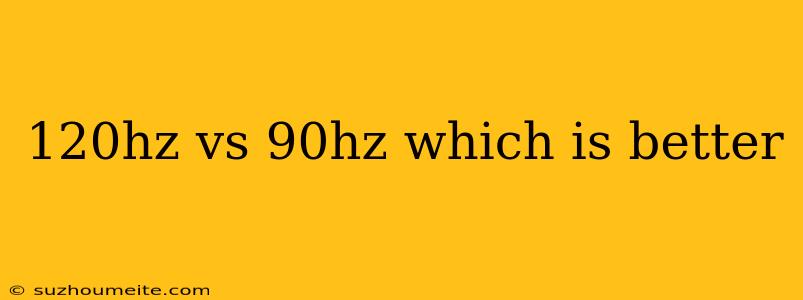120Hz vs 90Hz: Which is Better?
When it comes to displays, one of the most important aspects to consider is the refresh rate. A higher refresh rate can provide a smoother and more immersive viewing experience. Two of the most common refresh rates found in modern displays are 120Hz and 90Hz. But which one is better? In this article, we'll dive into the details of each refresh rate and help you decide which one is right for you.
What is Refresh Rate?
Before we dive into the comparison, let's quickly explain what refresh rate is. Refresh rate refers to the number of times a display updates the image on the screen per second. It's measured in Hertz (Hz) and is usually expressed in numbers such as 60Hz, 90Hz, or 120Hz. A higher refresh rate means a smoother and more responsive display.
120Hz: The Higher Refresh Rate
A 120Hz display refreshes the image 120 times per second, which is significantly higher than the standard 60Hz found in most TVs and monitors. This higher refresh rate provides several benefits:
Smoother Motion
A 120Hz display can display more frames per second, resulting in smoother motion and reduced screen tearing. This is especially important for fast-paced content such as sports, action movies, and video games.
Better Gaming Experience
Gaming on a 120Hz display can be a game-changer (pun intended). The higher refresh rate allows for a more responsive and immersive gaming experience, making it ideal for fast-paced games that require quick reflexes.
Reduced Screen Tearing
Screen tearing occurs when the display shows multiple frames at once, causing a tearing effect. A 120Hz display reduces the likelihood of screen tearing, providing a more seamless viewing experience.
90Hz: The Middle Ground
A 90Hz display refreshes the image 90 times per second, which is still higher than the standard 60Hz. While it may not offer the same level of smoothness as a 120Hz display, it still provides several benefits:
Smoother Than 60Hz
A 90Hz display is still significantly smoother than a 60Hz display, making it a good option for those who want a better viewing experience without breaking the bank.
Power Efficiency
90Hz displays tend to be more power-efficient than 120Hz displays, which can be beneficial for those who want to save energy or have battery life concerns.
Cost-Effective
90Hz displays are generally cheaper than 120Hz displays, making them a more affordable option for those on a budget.
Which is Better?
So, which refresh rate is better? The answer ultimately depends on your needs and preferences.
If You're a Gamer
If you're a serious gamer, a 120Hz display is the way to go. The higher refresh rate provides a more immersive and responsive gaming experience that can give you an edge over your opponents.
If You're on a Budget
If you're on a budget, a 90Hz display is a great option. It still provides a smoother viewing experience than a 60Hz display and is more affordable than a 120Hz display.
If You Want the Best of Both Worlds
If you want the best of both worlds, consider a display that can switch between 120Hz and 90Hz modes. This way, you can take advantage of the higher refresh rate when gaming or watching fast-paced content, and switch to the lower refresh rate to save power when you don't need it.
In conclusion, both 120Hz and 90Hz displays have their advantages and disadvantages. While a 120Hz display provides a smoother and more immersive viewing experience, a 90Hz display is a more affordable and power-efficient option. Ultimately, the choice between the two comes down to your specific needs and preferences.
